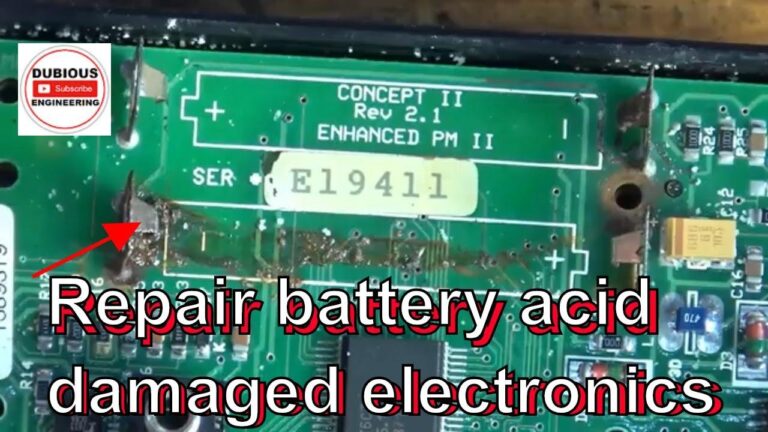Table of Contents
- Understanding the Risks and Limitations of Repairing Damaged Batteries
- Effective Techniques for Safe Battery Repair and Handling
- The Environmental and Practical Benefits of Battery Recycling
- Best Practices for Disposing and Recycling Damaged Batteries Responsibly
- To Wrap It Up
Understanding the Risks and Limitations of Repairing Damaged Batteries
Repairing damaged batteries poses significant challenges and potential hazards that should never be underestimated. Batteries, especially lithium-ion types, contain volatile chemicals that can react unpredictably when compromised. Attempting repairs without proper expertise can lead to issues like overheating, leaks, or even explosions. It’s important to understand that while some external damages might seem fixable, internal structural damage often remains hidden, making the battery unreliable or unsafe after repair. Professional assessment and specialized equipment are crucial in determining whether a battery is repairable or if it should be replaced altogether.
Additionally, there are limitations related to the lifespan and performance of repaired batteries. Even if a battery is successfully restored, its capacity and efficiency may be permanently reduced, impacting device functionality and output. Users should consider alternative routes such as:
- Certified recycling programs that extract valuable materials safely
- Purchasing manufacturer-approved replacements to ensure warranty and safety
- Using professional services that adhere to industry regulations
Effective Techniques for Safe Battery Repair and Handling
When working with damaged batteries, prioritizing safety is paramount. Always begin by wearing protective gloves and goggles, ensuring you minimize direct contact with corrosive materials or potentially hazardous leaks. Use insulated tools to reduce the risk of short circuits, and avoid exposing batteries to open flames or high heat sources, which can trigger fires or explosions. Before any repair attempt, thoroughly inspect the battery for bulges, deep punctures, or leaks-these are often signs that the battery is beyond repair and should be recycled immediately. Proper ventilation in your workspace is also essential to avoid inhaling toxic fumes released from compromised battery cells.
Effective handling also means adopting proper disposal and recycling practices when repair is not viable. Many communities offer specialized battery recycling programs designed to safely process hazardous materials. When storing or transporting damaged batteries, keep them in non-conductive containers and separate from other metallic objects to prevent accidental shorting. Additionally, labeling these batteries clearly helps recycling centers or waste handlers identify the risk level and handle them appropriately. Ultimately, adhering to these techniques not only safeguards your health but also minimizes environmental impact.
- Wear protective gear: gloves, goggles, and long sleeves.
- Use insulated and non-metallic tools.
- Inspect for damage signs: swelling, leaks, and cracks.
- Ensure proper ventilation in your workspace.
- Store batteries separately in non-conductive containers.
- Utilize certified battery recycling centers for disposal.
The Environmental and Practical Benefits of Battery Recycling
Recycling batteries significantly reduces the environmental impact caused by the extraction and processing of raw materials. Hazardous substances in damaged or used batteries, such as lead, mercury, and cadmium, can leach into soil and water, posing serious risks to ecosystems and human health. By ensuring these materials are recovered and properly handled, battery recycling minimizes pollution and conserves precious resources. Additionally, recycling reduces the need for mining activities, which are often energy-intensive and environmentally disruptive.
From a practical standpoint, battery recycling offers a sustainable method to reclaim valuable metals like lithium, cobalt, and nickel – elements that are critical components in new batteries and electronic devices. This circular approach not only lowers production costs but also supports the growing demand for renewable energy storage and electric vehicles. Key benefits include:
- Resource conservation: Extends the lifecycle of scarce raw materials.
- Energy efficiency: Uses less energy than producing batteries from virgin materials.
- Reduced landfill waste: Prevents toxic battery components from entering waste streams.
- Economic opportunities: Supports green jobs in recycling industries.
Best Practices for Disposing and Recycling Damaged Batteries Responsibly
When dealing with damaged batteries, safety must be the top priority. It is essential to avoid any attempts to repair them at home, as damaged batteries can leak hazardous chemicals, catch fire, or even explode. Instead, the most responsible action is to handle these batteries with care by placing them in a durable, non-conductive container and labeling them clearly as damaged. This precaution minimizes risks during transportation and storage before they reach recycling facilities designed to manage such waste safely.
Recycling damaged batteries requires specialized processes to recover valuable materials like lithium, cobalt, and nickel while neutralizing toxic components. To support proper recycling, always follow these best practices:
- Locate certified battery recycling centers that comply with environmental regulations.
- Never dispose of damaged batteries in regular trash bins or household recycling containers.
- Use drop-off programs or hazardous waste collection events organized by local authorities or retailers.
- Inform recyclers about the battery’s condition so they can handle it appropriately.
To Wrap It Up
In conclusion, while the idea of repairing damaged batteries might seem appealing for both environmental and economic reasons, safety must always come first. Most damaged batteries pose significant risks and should only be handled by professionals equipped with the right tools and expertise. When it comes to disposal, recycling remains the safest and most responsible option, helping to recover valuable materials while preventing environmental harm. By choosing proper recycling channels and staying informed about battery care, we can all contribute to a safer, greener future. Remember, when in doubt, it’s best to leave battery repair to the experts and prioritize recycling to keep our planet healthy.Check Our Other Blogs
- StunGun – Your Trusted Source for Stun Guns, Laws, and Self-Defense Tips
- PepperSprayLaws – Your Trusted Resource for Pepper Spray Information
- StunGunLaws – Your Trusted Guide to Stun Gun Legality and Safety





